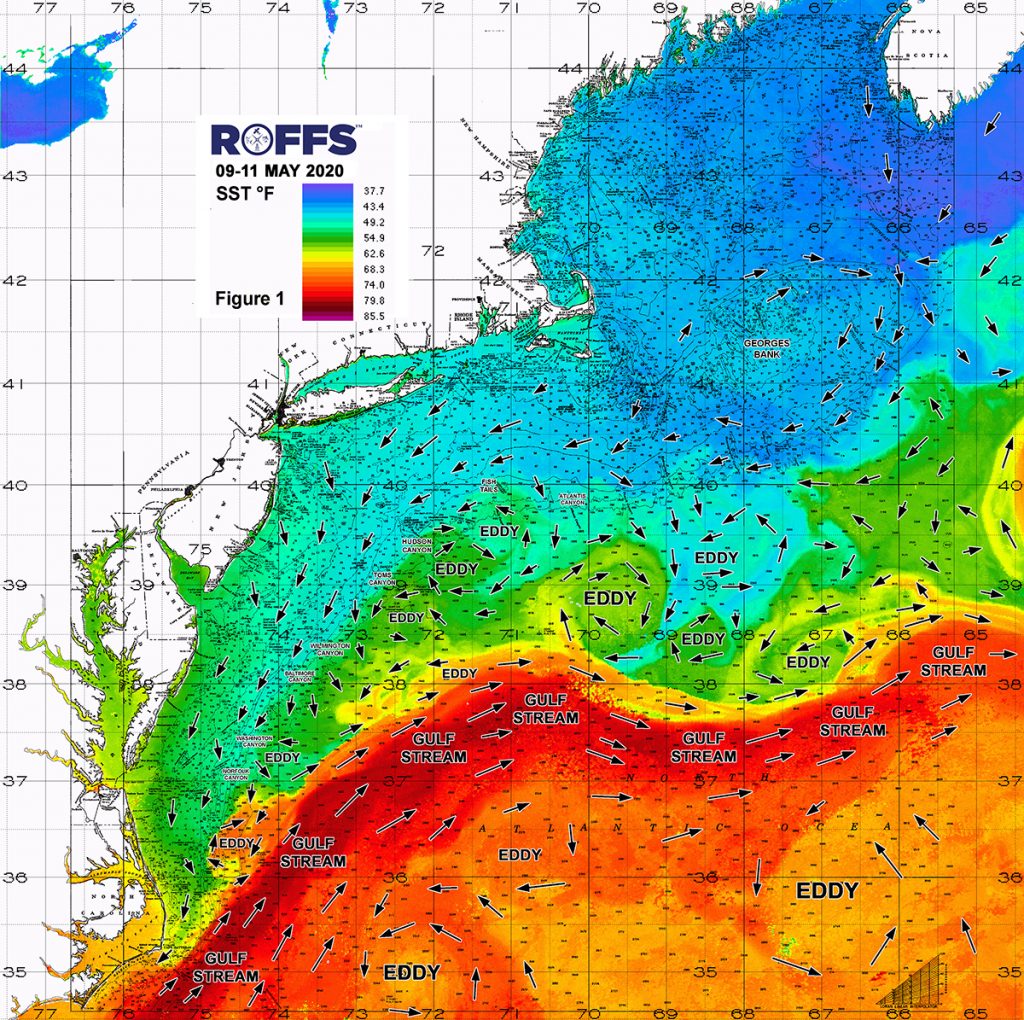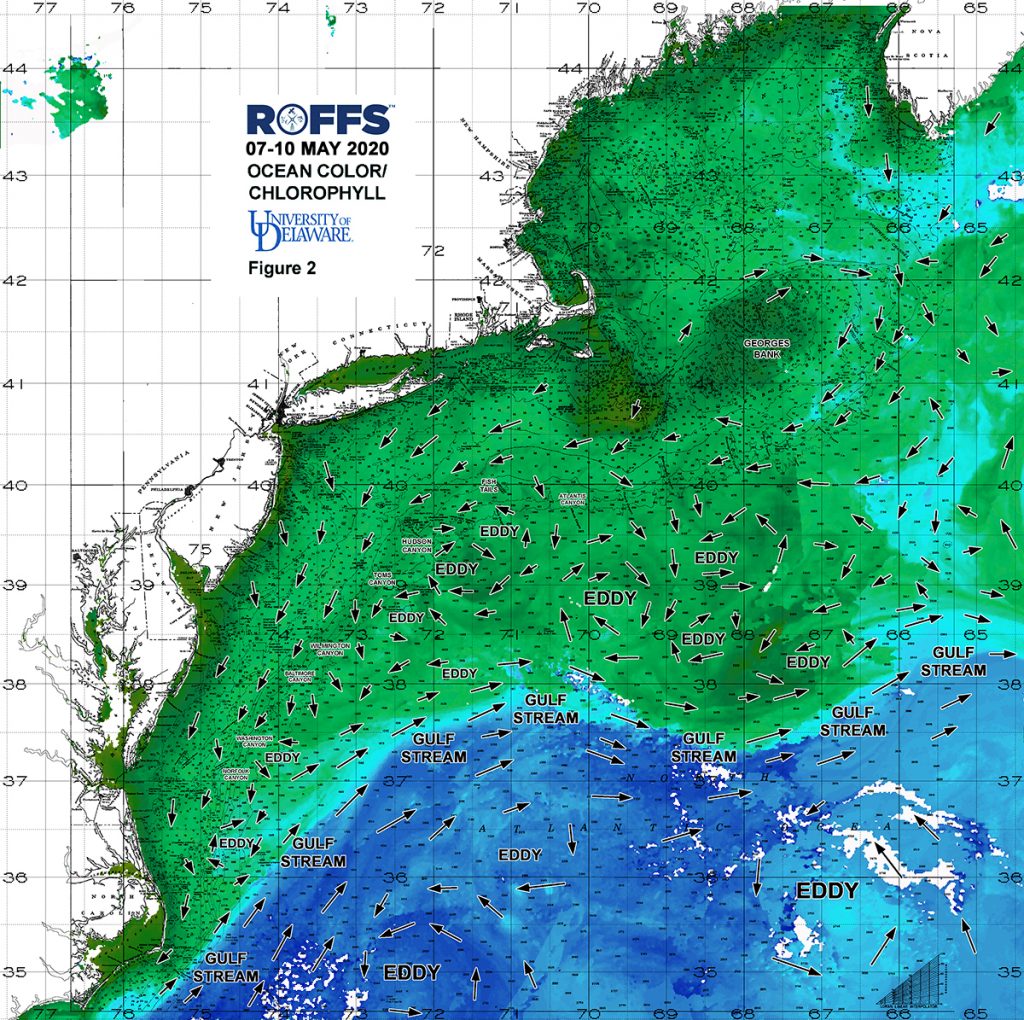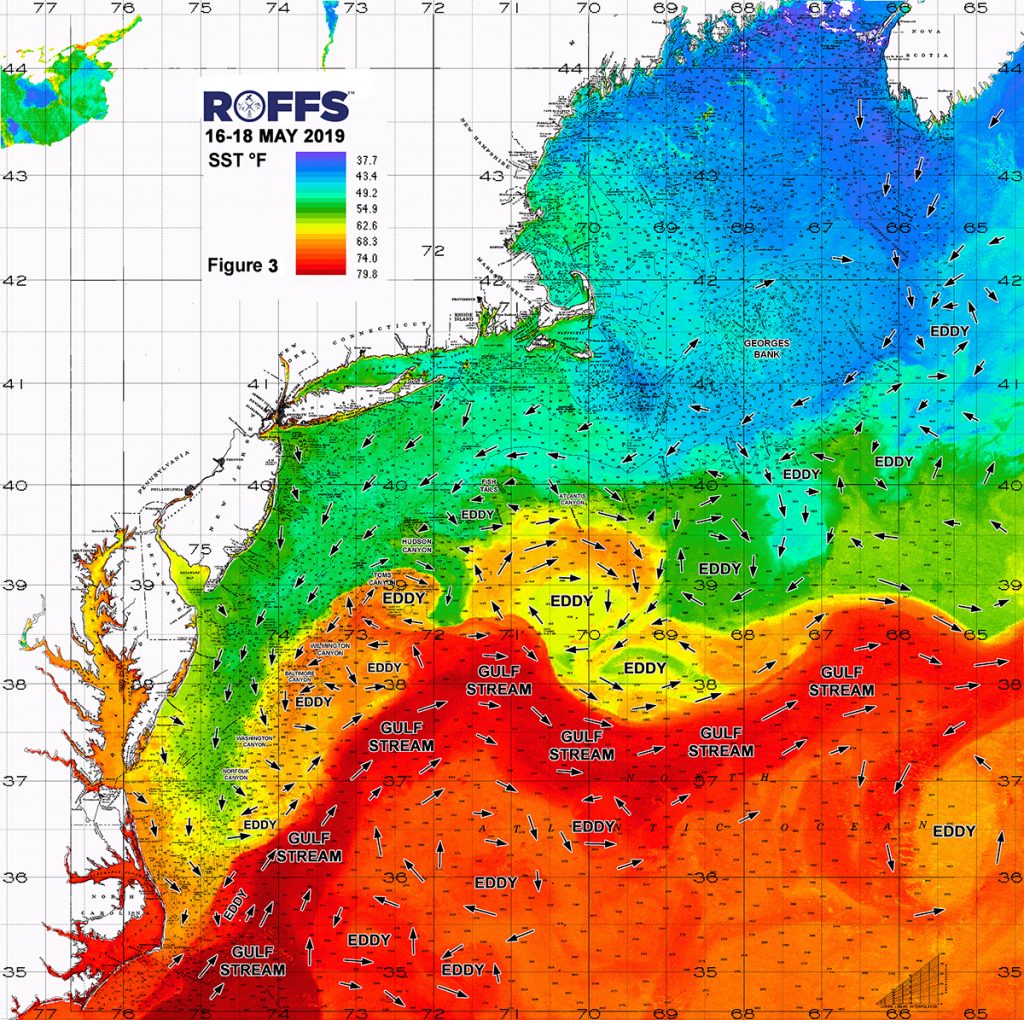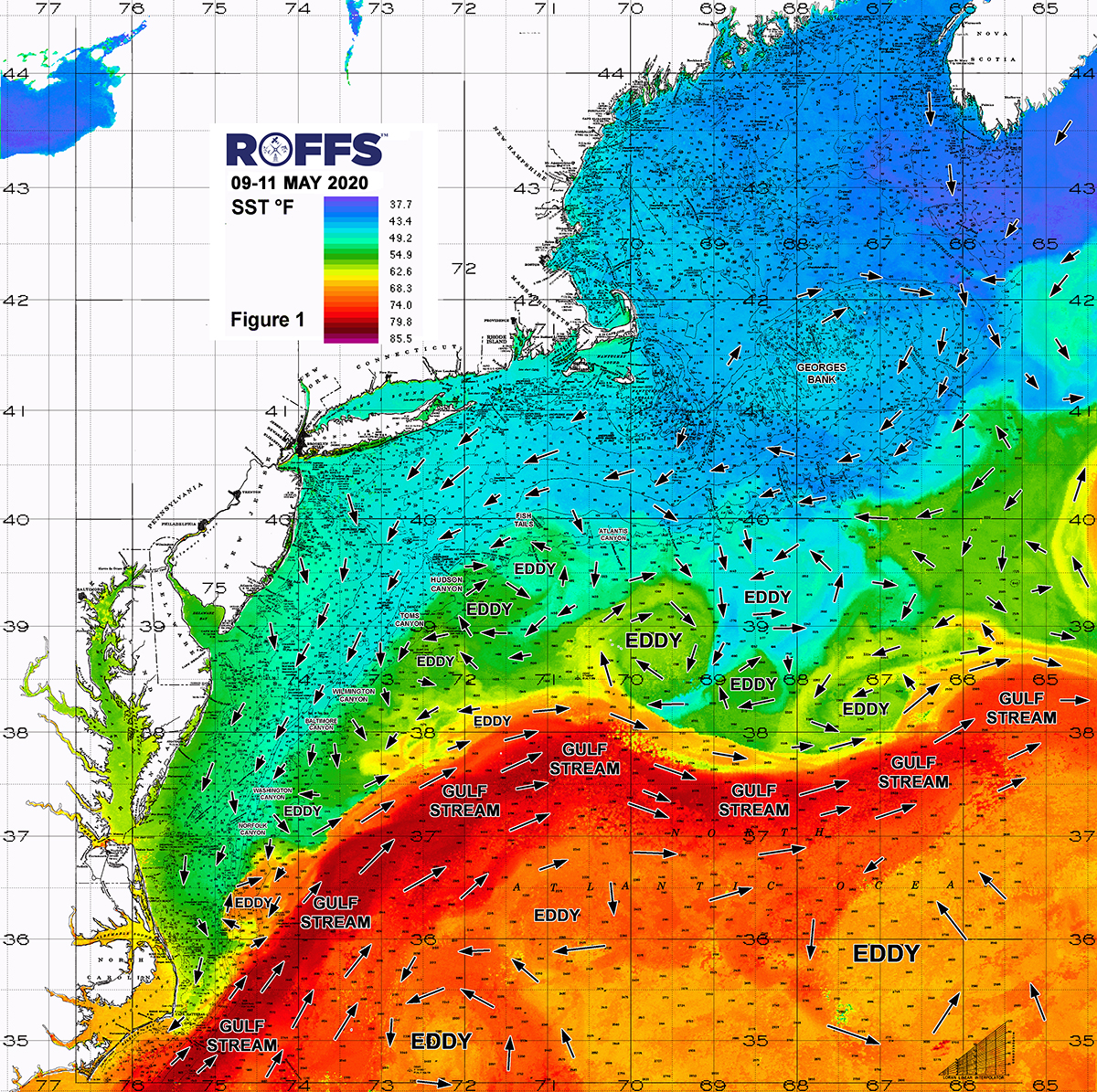Please click here to view full 2020 ROFFS™ North Season Fishing Forecast as a PDF.
Northeast U.S. Season Preview 2020: SLOW START BUT CONDITIONS SHOULD START HEATING UP SOON
By: Matthew A. Upton
ROFFS™ concludes its 2020 spring preview series by providing an overall update of the oceanographic conditions from mid-May offshore of the northeastern United States focusing in on the Mid-Atlantic Bight region and its canyons that includes the zone from Cape Hatteras to Georges Bank into the Gulf of Maine. We again utilized a combination of many different data sets mainly satellite derived sea surface temperature (SST) and ocean color/chlorophyll images. In this edition we will discuss the present ocean conditions and what it means for the upcoming late-spring to summer fishing season for the Cape Hatteras, NC to Massachusetts offshore area.
As a reminder, for forecasting short-term oceanographic conditions related to finding fish, ROFFS™ uses real-time direct observations. We have learned that evaluating the preseason conditions along with regional, downscaled climate models provides insight into future seasonal trends for fishing. Experience and understanding the ocean – atmospheric dynamics is our guide as we have had moderate success in forecasting seasonal trends of fishing productivity based on the stepwise progression in the location of the fishes’ preferred habitat based on temperature and water color. Please reference our 2020 Bahamas forecast for more in-depth discussion on the environmental and climate indicators that goes into our detailed evaluation of the eastern United States fishing forecasting analysis (Click Here).
Background and Some Observations for 2020
It is important to look at the year-to-year trends including the anomalies to gain insight into the location and condition of the fishes’ preferred habitat compared with previous years. Comparing similar locations and features to last year during the same general time period early-to-mid-May we found that the SST of the core of the Gulf Stream off of Cape Hatteras, NC for 2019 was approximately 79.5°F – 80.5°F and for this year it is about 1.0°F warmer (80.5 to 81.2°F). The SST of the coastal water off of New Jersey, Delaware and Maryland is approximately 1.0°F to 2.0°F cooler this year than during the same time period in 2019. Furthermore, the SST offshore of Long Island is about 4.0°F to 5.0°F cooler than this time last year. These and other indicators that will be described below suggest a slightly early arrival of tuna, wahoo, dolphin and billfish into the Gulf Stream section of the northeast U.S. region this year compared to last year but a later arrival of the main population of tuna, wahoo, dolphin and billfish to the northern canyon regions. Part of this cooler inshore SST trend is due to the cooler overall weather pattern and higher winds for the spring season from North Carolina and north. Furthermore, the reason for the warmer than normal Gulf Stream temperatures could be due to the fact that atmospheric temperatures and climate remained warmer than normal for late winter and early spring season in the south. However, with June approaching as with the forecast for warmer temperatures, waters (especially inshore) will be starting to warm at an average rate of 0.5°F to 1.0°F per day.
One driver for trends and weather and for the spring SST’s in the Northeast U.S. region can be attributed to the North Atlantic Oscillation (NAO) and its positive phase during the first three months of the year but switching to a negative phase in April. NAO index is based on the atmospheric surface sea level pressure difference between the Subtropical (Azores) High and the Subpolar Low within the North Atlantic Ocean (https://www.ncdc.noaa.gov/teleconnections/nao/). Typically, positive NAO phases means higher winds, cooler SST and atmospheric temperatures, while the switch to a negative phase in April could mean a warming period and less winds in May which is encouraging for warming the SST and calmer winds that lead to relatively favorable fishing conditions. Another possible factor to consider is the El Niño phase in the Pacific Ocean. Currently we are in neutral El Niño year and it is forecasted by NOAA to remain a neutral El Niño year through the summer, which usually means average SST’s in the Gulf of Mexico, Caribbean and east to northeast Pacific, but it remains to be seen what that means for waters offshore of the Northeastern U.S.
Atmospheric temperatures along with SST should start to increase at a more rapid pace as Memorial Day approaches. Also, please see ROFFS™ recent Southeast U.S. Gulf Stream fishing conditions analysis (Click here). These Gulf Stream conditions to the south are usually a good indicator and associated with an abundance of mahi, yellowfin tuna and marlin along with other highly migratory species. Reports from April to early May have already indicated good dolphin and tuna action along both sides for the Gulf Stream edges from Florida to North Carolina. Based on historical observations we anticipate that these fish along with other tuna, mahi-mahi, wahoo and then billfish will continue and already have moved to the northeast U.S. regions from the Gulf Stream and then into the large eddy features that move over the canyon areas and as SST begin to rise. Additional good news is that marlin have already been spotted and caught off of South Carolina and North Carolina along with earlier than normal mahi-mahi and yellowfin tuna action off of the Point east of Cape Hatteras, which lines up with the warmer than normal Gulf Stream temperatures this year compared to the last two years.
Nowcast Analysis
One of the most valuable features that we look at when trying to forecast the region in the Northeast U.S. is the number, size and location of clockwise rotating warm-core Gulf Stream eddies that are located north of the Gulf Stream region from south of Georges Bank to offshore of New York, New Jersey to Delaware areas. These are eddies that have broken off from the Gulf Stream and tend to slowly drift westward toward the Atlantis Canyons to Hudson Canyon and then in a southwestward direction toward the Norfolk Canyon before being pulled back into the Gulf Stream. The environment associated with warmer usually blue water and the mixing boundaries of the eddy features provide valuable habitat for the highly migratory large pelagic fish that enter this region in the spring and early summer seasons. Although, last year appeared better than 2018 as far as good eddy features, warmer water and options for fishing, there are already a few encouraging signs that this year could also be productive as we will discuss in detail below. However, this year does not look quite as promising as last year due to the lack of these stronger eddies, position of the Gulf Stream and cooler waters in the inshore areas.
The recent spring satellite data shown in Figure 1 and 2, and the fishing reports we have already received may provide insight into the upcoming fishing season. Figure 1 was derived from a variety of U.S. (NOAA and NASA) and European (ESA) satellites to show the SST during May 09-11, 2020 period. Figure 2 was derived from the NASA MODIS ocean color satellites (Aqua and Terra) and ESA’s Sentinel 3A and 3B satellites showing the ocean color/chlorophyll image data during this same period May 07-10, 2020.
We used a combination of imagery over a few days with the time-tested ROFFS™ cloud reduction algorithm to produce these relatively cloud-free images over this large area. The time of the satellite passes and the amount of data taken from each image is not the same for the SST and ocean color images. Thus, there are some subtle differences in locations of where the water mass boundaries derived from the SST and chlorophyll/ocean color occur. In spite of these small discrepancies this image pair is considered more than adequate for the purposes of our seasonal discussion.
The directional flow of the water was derived from our ROFFS™ sequential image analysis techniques, following the water masses, image to image based on the water mass’s distinct, i.e. signature value. An example of this year’s SST satellite infrared imagery in a greytone movie can be found on the ROFFS™ YouTube™ site (https://www.youtube.com/watch?v=1hLMUFMMJNo). Viewing the movie several times allows one to visualize the flow of the Gulf Stream and other currents, where the darker greytoned water is the warmer water and white areas are clouds.

Figure 1: This year’s Northeast U.S. conditions were derived from a variety of infrared sensors to get SST from NASA, NOAA and ESA satellites during May 09-11, 2020. Main eddy features, canyons and surface currents are labeled.

Figure 2: This year’s Northeast U.S. conditions derived from the ocean color/chlorophyll imagery during May 07-10, 2020 from the Aqua and Terra sensors on the MODIS satellite provided by the University of Delaware and from Sentinel 3A & 3B ESA satellites. We consider this an image pair with the above SST Figure 1 image. Same main eddy features and surface currents labeled, white indicates clouds.
Looking at Figure 1, the most important features to highlight are the two main warm core clockwise rotating eddies that should continue to provide favorable conditions throughout the spring and early summer fishing conditions from south of Massachusetts to south of New York and in the canyon regions off of New Jersey to Delaware and Maryland to Virginia. There is an eddy centered, directly offshore of Hudson Canyon (near 71°45’W & 39°15’N) and another larger eddy centered well south between Veatch and Atlantis Canyon (near 69°40’W & 38°50’N). The smaller eddy off of Hudson Canyon is still relatively cool with SST at only 58°F-59°F in the core and has not had any Gulf Stream interaction recently, however, that does not mean that the SST below the surface is slightly warmer and could have some tuna, sharks and swordfish associated with it. The larger eddy to the east is more promising and has been interacting with the Gulf Stream pulling up water in the 60°F-65°F range toward the eastern canyons and should continue pull warmer Gulf Stream water toward the canyon areas and providing the pathway for the tuna and other migratory fish to enter the canyon areas soon as it drifts westward. In fact, we did have some reports in late-March and early April about bluefin tuna in or near the Washington Canyon.
Looking at these two aforementioned eddies, as the SST warms and if the Gulf Stream moves further north from its current location it is very possible these eddies will further interact with the Gulf Stream and pull in more productive waters in the near future and as these eddies progress westward then southwestward they will continue to provide good fishing conditions for the Fish Tails to Hudson Canyon southwest to Wilmington, Baltimore and Washington Canyons into June and July for favorable fishing conditions. Keep in mind that the Gulf Stream is the driving force to the south of these Canyon regions and it only takes a few days to a week for the Gulf Stream location to move farther north or shed another warm core eddy to improve the conditions in the Northeast U.S. and we already know there are tuna and mahi-mahi within the Gulf Stream region outside of North Carolina.
It is also important to look further east to the eddies and conditions forming east of the Hydrographer to Oceanographer Canyons and southeast Georges Bank. As these will likely be the features that contribute and progress west then southwest and what anglers will be targeting during the late summer season from the Gulf of Maine to the canyons south of New York to the canyons offshore of New Jersey, Delaware, Maryland and Virginia. At this time there does not appear to be any larger warm core eddies except the one that has formed way to the east (east of 65°00’W & 40°00’N) to track at this time. However, it only takes a few days to a week for the Gulf Stream to meander, shift and push farther north and form more warm-core eddies to further improve the fishing conditions so please stay in contact with ROFFS™ for your analysis and updates. Furthermore, in the next few weeks to month, the SST will continue to warm closer the bank providing opportunities for tuna, wahoo, dolphin and marlin to migrate farther north into the canyon areas and inshore for easier targets.
Looking at Figure 2, we are not concerned about the lack of bluer water over this region at this time because we are at the peak season of the spring algae bloom (as evident in the large abundance of greener water). This is an annual event that provides the food for many of the baitfish species for the next month or two. In fact, the overall color of the surface water is greener than this same time period last year. However, just because the surface water is greener in color, the offshore conditions, especially in the eddy features may be bluer in color below the surface as the algae bloom tends to be apparent in the top few meters of the water column.

Figure 3. Last year’s Northeast U.S. conditions were derived from a variety of infrared sensors to get SST from NASA, NOAA and ESA satellites during May 16-18, 2019. Main eddy features, canyons and surface currents are labeled.
Another indicator of this year’s spring to early summer fishing season is the orientation of the Gulf Stream. If you look at the location of the Gulf Stream in comparison to last year’s SST conditions (Figure 3) and compare it to this year’s conditions (Figure 1), you can see the Gulf Stream this year appears a bit more stable and shifted farther south than last year. This equates to the warmer pelagic fish pathway being located farther away from the inshore canyon areas, hence providing evidence to a slower start to the fishing season for most target species in the canyon regions.
Another effective indicator for forecasting a good 2020 season is the recent fishing reports. Unfortunately due to cooler than average weather, lack of reachable favorable conditions and the COVID-19 pandemic restrictions and uncertainty, we have gotten very few fishing reports between Massachusetts and Maryland. We have had encouraging reports of yellowfin, blackfin, mahi-mahi and billfish action off of North Carolina and east of Cape Hatteras that validates that the early arrival of target pelagics species are already within the Gulf Stream and Gulf Stream related filament water. However, at this time there area a lack of features and too cool of water to progress their pathway northward toward the canyon regions and closer to the Northeast U.S. coastal waters. As the SST warms and the weather improves we are optimistic that the conditions will improve over the next few weeks and really start to produce as more people fish into June. We also know from old reports and historical reports for this time of year, that bluefin tuna action is likely within the canyon regions and inshore where you find the SST warmer than 58°F/59°F. Furthermore, there are some promising conditions and 70°F and warmer and bluer water east of Virginia, south of Norfolk Canyon for tuna, dolphin, wahoo and billfish action where you do not have to travel south the main Gulf Stream edges.
Conclusion
Based on what we have been observing over the last several weeks with the lower number of Gulf Stream warm-core eddy features in the Northeast U.S. and the location of the Gulf Stream, it appears that the arrival of the larger populations of tuna, wahoo, mahi-mahi, and billfish may arrive later than the past two years to the offshore canyon regions. Compared to last year, the SST overall (other than the Gulf Stream) is cooler which tells us it is going to be a later arrival of most pelagic target species compared to last year including the main migration of tuna and marlin perhaps a few weeks later than the past couple of years. It remains to be seen how many bigeye tuna and albacore tuna will arrive this year, as this is still a mystery over the last few years. One encouraging report about bigeye tuna is that they have been catching bigeye on the eastern part of the Gulf Stream off of Florida so it is hopeful that as they migrate north, they will remain with the Gulf Stream regions and transition into the Northeast U.S. within the next month, if not already. We still have so much to learn about the distribution and migrations of these and other fish and their association with different oceanographic conditions. Bigeye tuna tend to stay deeper in water column and are many times associated with pilot wales and come into the canyon areas early in the morning or early evening to feed then go back offshore. This is one trend we continue to monitor. Yellowfin tuna is another mystery most years, as usually the best yellowfin action is during May and June then becomes better again in mid-to-late September and early October. The GOOD NEWS is this year with the cooler SST conditions, that the yellowfin tuna action may arrive later than normal and be good in the months of June into July and maybe August.
We encourage you to take a look at these early season conditions and if you have not already get your boat ready and get offshore when the weather permits and the SST warms in the next few weeks. The bottom line is, the existing oceanographic conditions and fishing reports suggest, especially for the North Carolina and Virginia crowd, that you should already have boats in the water and fishing if you are able. For the Massachusetts to New York to New Jersey, Delaware, and Maryland crowd, you should be in final preparations to try to get offshore when the weather permits and restrictions start to be lifted as the water is going to warm inshore and offshore and conditions will continue to improve rapidly especially for swordfish, sharks and tuna and soon to be mahi then wahoo and billfish into June.
It is important to remember that good fishing action on a daily basis is strongly linked to local, short-term (days) current conditions that concentrate the fish once the preferred habitats of the fish are in a particular region. When the water mass boundaries associated with these currents are geographically stable and favorable, i.e., persistently pushing over “good” bottom topography and/or in a favorable inshore direction, then they concentrate the baitfish and larger fish can be found foraging. This indicates that the fishing action on any given day is controlled by relatively short-term (hourly to daily) and relatively small-scale (5-10 mile) movements of the currents and their water mass boundaries. Our experience indicates that to reliably forecast specific concentrations of fish on a daily basis one must evaluate the ocean conditions on these scales. Relatively small subtle changes in the currents and their associated water mass boundary zones often have dramatic effects on the distribution and concentration of fish.
Contact ROFFS™ (1-321-723-5759 / fishing@roffs.com / roffs.com, @roffsfishing on Facebook and Instagram) for the up-to-date detailed fishing conditions and get the inside track to where the better fishing locations will be tomorrow. Our experienced satellite and fishery oceanographers will continue to monitor the northeast U.S. oceanographic conditions closely as the shark and tuna season quickly improves and the active summer fun fishing and tournament season rapidly approaches. Also, please investigate and download the mazu SportFishing app from the Mac App Store for your iPad. We have partnered with mazu where you can open our analysis on their app and our hot spot locations can now be overlaid and georeferenced on real time offshore satellite data (https://www.mazu-marine.com/sportfishing/) for increased accuracy and accessibility. We at ROFFS™ know that the safety and health of everyone comes first but we are also hopeful that the COVID-19 pandemic does not affect the sport we all love and look forward to this summer. Remember, the safest place to social distance is offshore on the water and follow your local guidelines. We also hope that tournaments in the Northeast U.S. consider to remain on schedule and alter their social events and provide online captain meetings and weigh-ins to keep all participants safe but also provide a relief to get out into the ocean and have some fun in a safe, responsible way. Call ROFFS™ if we can assist in any way.
Safe and Successful Fishing!
ROFFS™ Team
[/et_pb_text][/et_pb_column][/et_pb_row][/et_pb_section]





